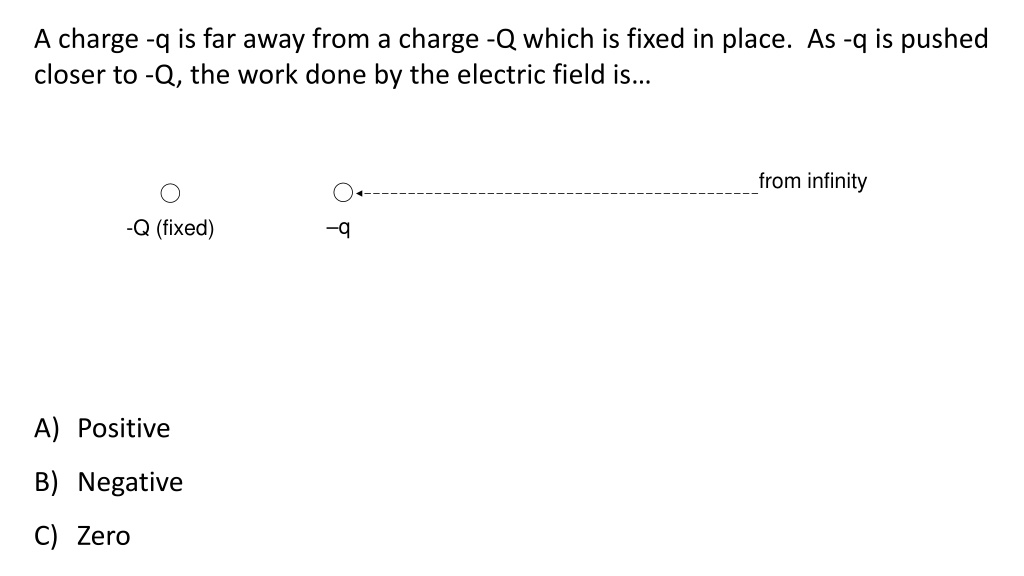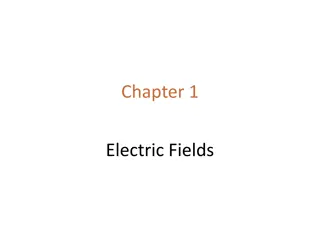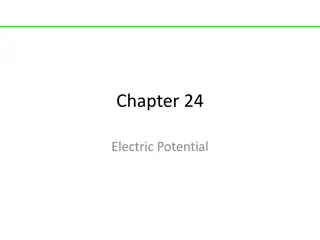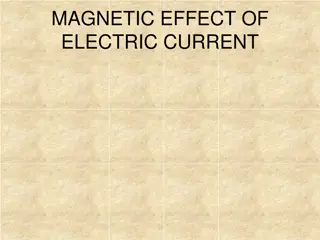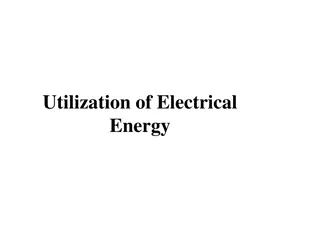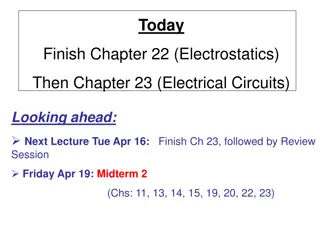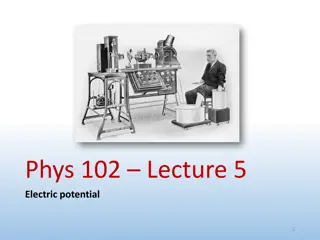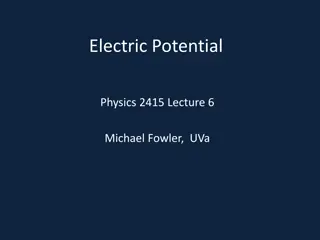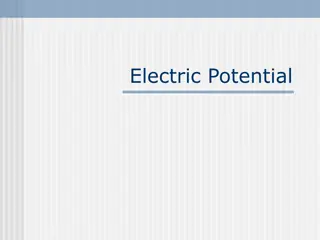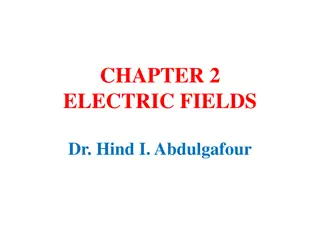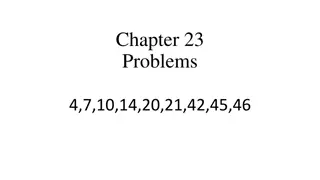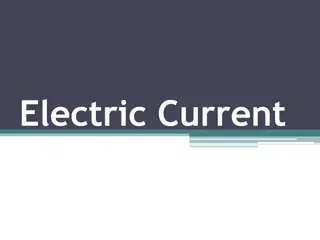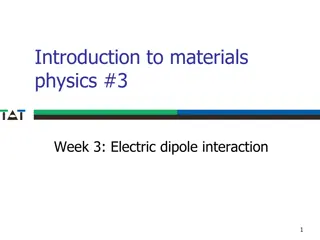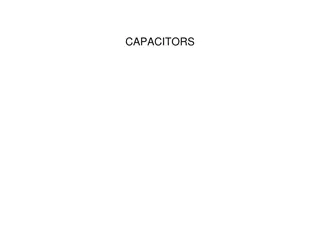Understanding Electric Field Work and Potential Energy Changes
Exploring scenarios involving charges moved in electric fields, determining work done, changes in potential energy, and charge movements. Clarification on external agent work, system energy changes, and charge direction predictions provided.
Download Presentation

Please find below an Image/Link to download the presentation.
The content on the website is provided AS IS for your information and personal use only. It may not be sold, licensed, or shared on other websites without obtaining consent from the author. Download presentation by click this link. If you encounter any issues during the download, it is possible that the publisher has removed the file from their server.
E N D
Presentation Transcript
A charge -q is far away from a charge -Q which is fixed in place. As -q is pushed closer to -Q, the work done by the electric field is from infinity q -Q (fixed) A) Positive B) Negative C) Zero
Suppose the push by the external agent is such that ? moves towards ? at constant velocity. The work done by the external agent is bringing the minus charge in from infinity is from infinity q -Q (fixed) A) Positive B) Negative C) Zero
Again, suppose the motion is at constant velocity. The change in energy of the system of these two charges is from infinity q -Q (fixed) A) Positive B) Negative C) Zero
A positive test charge +q is carefully moved by some external agent (lets call it tweezers ) at constant speed a distance x between two large plates in the direction along the electric field. The work done by the agent, done by the electric field, and done by the net force on the test charge are: agent field net force A) + - + B) - + - C) - + 0 D) + - 0 Note: For clarity in showing the trajectory, not all field lines are shown E) None of these
A positive test charge +q is carefully moved by some external agent (lets call it tweezers ) at constant speed a distance x between two large plates in the direction along the electric field. The change in electric potential energy ( ? = ? ?? ?????) of the positive test charge was A) ? is positive (PE increased) B) ? is negative (PE decreased) Note: For clarity in showing the trajectory, not all field lines are shown C) ? is zero (PE is constant)
A positive test charge +q is carefully moved by some external agent (lets call it tweezers ) at constant speed a distance x between two capacitor plates in the direction along the electric field. The change in electric potential ( ? = ?/?) of the positive test charge was A) + (V increased) B) - (V decreased) Note: For clarity in showing the trajectory, not all field lines are shown C) 0 (V constant)
A small positive test charge is initially at rest in an electric field, and is free to move. Which way will the charge start to move? A) Moves toward higher potential B) Moves toward lower potential C) Not enough information is given
A beam of electrons is deflected as it moves between oppositely charged parallel plates. Which plate is at the higher potential? A) The upper plate B) The lower plate C) They are at the same potential
Consider 4 charges +Q, +Q, Q, and Q arranged in a square, with points X and Y located midway between a pair of charges, as shown. At point X the potential is +Q Q Y Q +Q X A)Positive B)Negative C)Zero
Consider 4 charges +Q, +Q, Q, and Q arranged in a square with point Y located midway between a pair of charges, as shown. At point Y the potential is +Q Q Y Q +Q X A)Positive B)Negative C)Zero
Two test charges are brought separately into the vicinity of a charge +Q. First test charge +q is brought a distance r from +Q. Then +q is removed and a test charge +2q is brought a distance 2r from +Q. Which charge configuration required more work (done by the external agent moving the test charge) to assemble? r 2r A) B) +q +2q +Q +Q A)A B)B C)Both required the same work
A point charge +q is brought (at constant speed) from infinity to a point b near 3 other charges +Q, Q, and +2Q. The charge q is brought along 3 different paths in turn, path 1, path 2, and path 3, as shown. Along which path is the most work done by the external agent carrying the charge +q? +2Q +Q path 1 path 2 b Q path 3 A) path 1 B) path 2 C) path 3 D) same work on all three paths
A point charge +q is brought (at constant speed) from infinity to a point b near 3 other charges +Q, Q, and +2Q. The sign of the total work done by the external agent is +2Q +Q path 1 path 2 b Q path 3 A) positive. B) negative. C) The total work by the external force is zero.
Points A and B are distances r and 3r respectively from a point charge q. What is the magnitude of the potential difference between points A and B? 2?? 3? A) ?? 3? B) 8?? 9? C) 3?? 4? D) E) none of these
Consider a point in empty space near several charges, which might be positive, negative, or both. Consider the following statements. I. The E-field can be zero at a point where the potential is non-zero. II. The potential can be zero at a point where the E-field is non-zero. Which of these statements can be true? A) both can be true B) neither can be true C) only I can be true D) only II can be true
The equipotentials shown are created by positive charges which sit in the center of each of the two areas of high potential. Which charge has a larger magnitude? A)The left charge B)The right charge C)They have the same magnitude
A test charge (+q) is carried from point i to point f at constant speed. The work done by the external agent carrying the test charge is A)positive B)negative C)zero D)depends on the path taken from i to f
A constant uniform E-field of magnitude E = 1V/m points up. Point a is (2m, 3m) and Point b is (5m, 7m). What is the magnitude of the potential difference |V(b) V(a)| ? A)5 V B)4 V C)3 V D)None of these
The equipotential surfaces around a line of charge(into the page) are shown. Each equipotential is 2m from the nearest-neighbor equipotentials. What is the approximate magnitude of the electric field at point A? -2.5V -1.8V -2.3V A A) 0.1 V/m -2.1V 0V -1.4V B) 0.2 V/m C) 0.4 V/m D) 0.6 V/m E) None of these
If the total or net potential V of an array of charges versus the distance from the charges is as shown in graph 1, which graph A, B, C, D, or E shows the electric field as a function of distance r? In the graphs, if the field points in the positive r direction, it is said to be positive.
Consider the following locations in a uniform electric field of magnitude ? = 3 V/m. and rank the electric potential. A B 4 m C ? = 3 V/m 1 m A) ??= ??= ?? B) ??= ??> ?? C) ??> ??= ?? D) ??> ??= ?? E) ??= ??> ??
If the E-field throughout a region of space is zero, the electric potential throughout that region must be zero. A) True B) False
If the electric potential throughout a region of space is zero, the E-field throughout that region must be zero. A) True B) False
A large sphere is initially charged with total charge +Q. A wire now connects the large sphere to a small sphere. Once the system comes into static equilibrium, what is the potential on the surface of the spheres? [Assume all objects are conductors and the spheres are very far apart] A) ??> ?? B) ??< ?? C) ??= ??
Once equilibrium is reached, how does the total charge on the surface of each sphere compare? [Hint: Outside a uniformly charged sphere, the electric field exactly matches that of a point charge at the center of the sphere] A) ??> ?? B) ??< ?? C) ??= ??
Once equilibrium is reached, how do the magnitudes of the electric fields at the surfaces compare? ? ? A) ??> ?? B) ??< ?? C) ??= ??= 0 D) ??= ?? 0
The surface of a spherical balloon has a fixed net charge of ? spread uniformly over its surface (it has a uniform negative charge per area). The balloon is slowly deflated. As it is deflated and its diameter shrinks, the total energy contained in the electric field due to the charge A) increases. B) decreases. C) remains constant.
A capacitor with capacitance C is attached to a battery with voltage V. What is the flux ? ?? through the cubical volume shown? (The end faces of the cube are within the metal plates of the capacitor. ?? ?0 A) 2?? ?0 B) C) zero D) none of these
A capacitor has a voltage V across its plates. An electron, initially at rest, is released from at a point very close to the negative plate of a capacitor and it accelerates toward the positive plate. The electron has charge e and mass m. There is no gravity in this problem. What is the final kinetic energy of the electron just before it collides with the positive plate? A) ??? B) 2?? 1 2??2 C) D) ?? E) None of these
If we fix the charge (keep it constant) and double the spacing between the plates ?, what happens to the electric field between the plates? A) no change B) increases by a factor of 2 C) increases by a factor of 4 D) decreases by a factor of 2 E) none of these
Again, if we fix the charge and double ?, what happens to the voltage (potential difference) between the plates? A) no change B) increases by a factor of 2 C) increases by a factor of 4 D) decreases by a factor of 2 E) none of these
Again, if we fix the charge and double d, what happens to the capacitance? A) no change B) increases by a factor of 2 C) increases by a factor of 4 D) decreases by a factor of 2 E) none of these
A capacitor of capacitance C holds a charge Q when the potential difference across the plates is V. If the charge on the plates is doubled to 2Q, a) the capacitance becomes (1/2)C. b) the capacitance becomes 2C. c) the capacitance becomes (1/4)C d) the capacitance becomes 4C e) the capacitance does not change.
Does the capacitance of a given capacitor depend on whether it is uncharged, half charged, or fully charged? A) Yes B) No C) Depends on the type of capacitor
How much work does it take to move a charge of +?? from the bottom plate to the top plate of a capacitor with charge Q and electric field E? A) ?? = ?? ? ? B) ?? = ?? ?2 ? C) ?? = ?? ? ? D) ?? = ?? ?
A charged capacitor is isolated (so no charge can get on or off). The plates of the capacitor are slowly pulled apart. After the plates are pulled apart a bit, the electric field between the plates A) increased B) decreased C) remained constant
A charged capacitor is isolated (so no charge can get on or off). The plates of the capacitor are slowly pulled apart. After the plates are pulled apart a bit, the potential difference between the plates A) increased B) decreased C) remained constant
A charged capacitor is isolated (so no charge can get on or off). The plates of the capacitor are slowly pulled apart. After the plates are pulled apart a bit, the capacitance A) increased B) decreased C) remained constant
A parallel plate capacitor is charged (the plates are isolated so Q cannot change). The plates are then pulled apart so that the plate separation d increases. The total electrostatic energy stored in the capacitor A) Increases B) Decreases C) Stays the same
What if the two plates were not isolated, but were attached to a battery, so that the voltage V between them is held fixed. Now, as we increase d, the electrostatic energy stored in the capacitor A) Increases B) Decreases C) Stays the same
A piece of dielectric material is placed in a uniform electric field. How does the electric field inside the dielectric compare to the field outside the material? A) ????= ??? B) ????> ??? C) ????< ???
A parallel plate capacitor is charged (the plates are isolated so Q cannot change.) A slab of dielectric (thickness L<d) is inserted between the plates, not connected to either one. Upon insertion of the slab, the voltage difference between the plates A) Increases B) Decreases C) Remains the same
After insertion of the slab, the ratio Q/V where V is the voltage difference between top and bottom plates.. A) Increases B) Decreases C) Remains the same
A parallel plate capacitor is connected to a battery that maintains a constant potential difference across the plates. Initially, the space between the plates contains only air. Then, a Teflon (? = 2.1) sheet is inserted between, but not touching, the plates. How does the stored energy of the capacitor change as a result of inserting the Teflon sheet? A)The energy will decrease B)The energy will not be affected C)The energy will increase D)The energy will be zero joules
Consider any two capacitors ?1 and ?2 hooked together in parallel. They may or may not be hooked to a battery. What thing is definitely the same for the two capacitors? V C2 C1 C2 C1 A) The capacitance (?1= ?2) B) The voltage (?1= ?2) ( ? means ?, of course) C) The charge (?1= ?2) ( ? means +? on one plate and ? on other, of course) D) All of these E) None of these
Consider any two capacitors ?1 and ?2 hooked together in series. They may or may not be hooked to a battery. What thing is definitely the same for the two capacitors? C1 C1 V C2 C2 A) The capacitance (?1= ?2) B) The voltage (?1= ?2) ( ? means ?, of course) C) The charge (?1= ?2) ( ? means +? on one plate and ? on other, of course) D) All of these E) None of these
How do the voltages across the two capacitors relate to the voltage on the battery? C1 C1 V C2 C2 A) ? = ?1= ?2 B) ? = ?1+ ?2 C) ? = ?1 ?2 D) ? = ?2 ?1 E) ? is not related in any definite way to ?1 and ?2
Two identical parallel plate capacitors are given the same charge Q, after which they are disconnected from the battery. Now, C2 is filled with a dielectric. Compare the potential energy stored by the two capacitors. A) ?1> ?2 B) ?1= ?2 C) ?1< ?2
A circuit consists of three identical capacitors ?1= ?2= ?3= ?, which are connected to a battery of voltage ?0. The capacitors obtain charges ?1, ?2, and ?3. Compare ?1, ?2, and ?3. A) ?1> ?3> ?2 B) ?1> ?2> ?3 C) ?1> ?2= ?3 D) ?1= ?2= ?3 E) ?1< ?2= ?3
